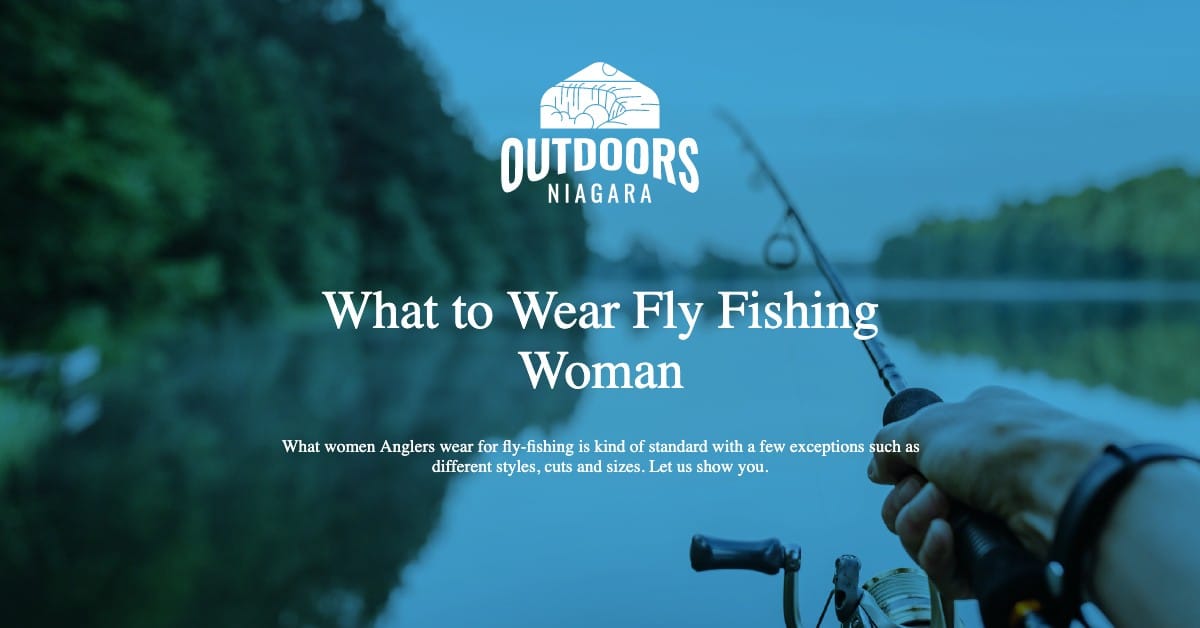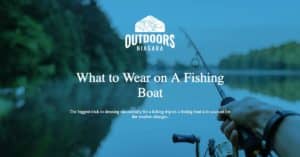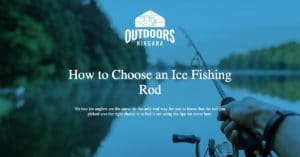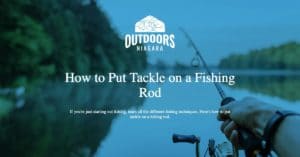What women Anglers wear for fly-fishing is kind of standard to what their male counterparts wear – with a few exceptions such as different styles, cuts, and sizes.
The following list allows you to find comfort while fishing and protection from the elements and wildlife.
There is the attire for women including clothing lines that are designed specifically for the fisherwoman.
You will find something more tailored for the adventurer in you.
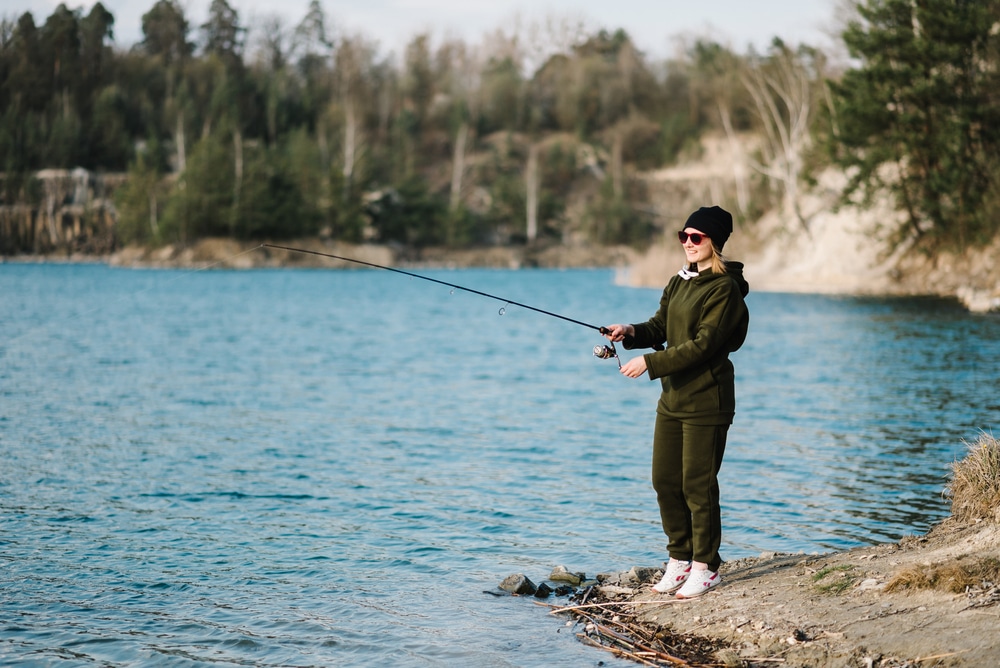
Contents
1. Sunscreen
Protection from the sun is an essential part of every angler’s wardrobe.
The sun on the water refracts back at you, so you end up exposed to twice the amount of UV radiation.
Sun protection is vital for the health and longevity of every angler.
Shop for quality waterproof sun protection that gives you the extra protection you need.
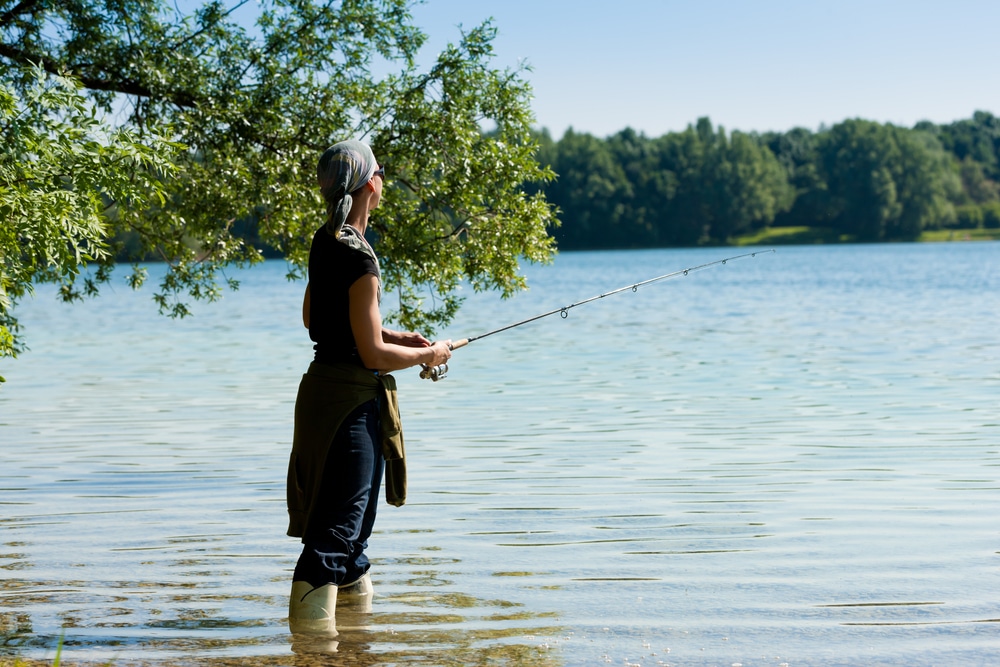
2. Sunglasses
Sunglasses are also essential but not just any pair of quality sunglasses will do.
Anglers need polarized sunglasses to be able to see fish in the water.
A pair of polarized sunglasses will cut the glare, so you can improve sight fishing.
A polarized pair of sunglasses is essential, and you want one that fits your head comfortably.
Avoid the bulky pair as they will interfere with your fly-fishing technique.
3. Rain Gear
Rain gear and fly-fishing go hand in hand.
Many of the best fly-fishing places in the world have unusual amounts of rain.
Some of the best fly-fishings occurs in the rain.
A hooded rain jacket that is waterproof allows you to toss flies at fish regardless of the weather.
If you plan on fishing often you will need a lightweight rain jacket for warmer days and unsettled weather and a heavier rain jacket for when there is more than just a chance of afternoon rain.
4. All Weather Clothing
Fly-fishing takes you through all types of weather and often in a single day.
For many active women, a quality base layer as clothing for women is a place to start for handling changes in weather.
Many anglers use a multiple base layer approach to handling extreme weather.
Without compromise on a range of motion, the extra layer on layer plan helps to keep you warm on cold days and allows you to shed a layer of warmth to cool down as needed.
The middle layer is perfect for early fall and late spring weather, but be sure to add leg layers to keep you warm and protected.
A mid-layer, outer layer, and base layer are good places to start to keep the body temperature regulated.
Think of a quality base shirt with a base layer or underwear layer too.
Top off the look with a quality jacket that offers waterproof and windproof features.
5. Fishing Vest
Because fly-fishing is a little different from regular fishing, you need to be able to carry your fishing gear, fly patterns, and tools on you.
Most of the time you are waist-deep in a river or lake tossing flies and carrying a tackle box is not practical.
Fly-fishing shirts and fishing apparel designed to help you safely care for your gear are essential.
At the heart of these are fishing vests. A fly-fishing shirt is good on warm days, but a day of fishing in colder weather requires a fly-fishing vest.
6. Waders
Waders are an essential part of fly fishing.
You spend a great deal of time standing in water and waters with boots or without wader boots are important.
Wading boots and hip waders are options you can choose if you plan to keep to shallow wading.
Boot foot waders – those with the boot molded into the legs of the waders are common, but felt-soled waders are very popular.
Be sure to check local regulations regarding felt-soled waders are they are not allowed in some areas.
Also, if you opt for waterproof boots, check with boot manufacturers before your boot purchase.
Not all waterproof boots are waterproof.
Because you fish in water, the ground you stand on is slippery and sometimes muddy.
The boot setup, boot style, and boot technology for built-in boots, are critical.
Be sure that whatever you choose, that comfort and quality are the top two criteria for choosing waders and boots.
7. Cold Water Wear
Nothing takes the thrill out of fly-fishing like standing in cold water.
Water temperatures vary from place to place and seasonally.
Cold river water, while essential to fish species such as trout can seep through your waders and chill you to the bone.
Cold water can be dangerous, and it is important to address cold water through proper choice of clothing.
Thermal waders, boot warmers, and hand warmers are essential.
For colder water and weather, you will need waterproof clothing, including a jacket, socks, and boots.
Some anglers prefer heat packs that you can slip into your boot or gloves and others use battery-powered heaters that keep them warm.
There are choices available and the snap pack hand warmers are a good choice.
Most will keep emitting heat for up to eight hours, and they do not require a battery.
If you opt for a warmer, be sure to use insulating clothing to keep it from burning.
8. Fishing Apparel
There is a long list of clothing that is designed for fishing.
Everyone has their own style but what is important about fishing apparel is that it needs to be comfortable.
Fashion for women allows the fishing apparel to be more fit and customized for the normative female figure.
Fishing is an active sport and fishing shirts and fishing apparel, including fishing vests, need to pull double duty.
They not only should look nice, but they also need to allow you to move while they do their job of keeping you warm or offering to cool.
A beautiful fly-fishing shirt that does not allow you to cast properly will hamper your day of fishing.
The same is true of fishing jackets. Comfort is king.
9. Fishing Hats
Fishing hats have a few jobs to do while you fish. First, they help to keep the sun off of your face and head.
They also work with sunglasses to keep glare at bay.
A good fishing hat will improve your “water” vision, allowing you to see fish in the water without fighting glare.
A good hat improves your options for sight fishing.
Hats also help you battle the weather and keep you dryer and warmer.
10. Dry Packs
A dry pack is a waterproof backpack. For fly fishermen and women, being able to carry your gear on your back is essential.
It is difficult to fly fish out of a tackle box because fly-fishing requires two hands.
If you are waist-deep in a river, where do you carry your gear? A dry pack helps keep your gear dry and accessible.
11. A Fishing License Pouch
It may seem like a silly thing, but in some states, you are required to keep your fishing license visible.
A plastic fishing license pouch attaches to your hat, vest, or shirt, so the game warden can see you have a license from a distance.
12. UPF Shirts
UPF is the same as SPF rating on sunscreen. UPF, however, is designated for shirts for women.
If you are going to be outside in the sun, wearing UP clothing is essential.
A UPF hat and shirt are the basics, and you can add UPF fishing pants too.
13. Gaiters
For fly-fishing a gaiter is essential. They help to keep your neck warm and from getting sunburned.
Gaiters are tubular neck wraps that often have a hood.
These not only help to keep the sun off you, but they will also help you fight wind and rain too. Be sure to shop gaiters that have a UPF rating.
14. Tool Kit
A tool kit that either fits your waist, like a belt, or inside your waders if you use chest waders is essential.
This is the area where you keep tools that you may use suddenly.
An example would be bear spray. It is not uncommon to encounter wildlife while fly fishing.
A tool belt helps you to be prepared for situations that may not involve fishing.
15. Whistle
Not every angler carries a whistle but they should.
A whistle helps you call for help and can be a powerful deterrent for bears and other aggressive wildlife.

